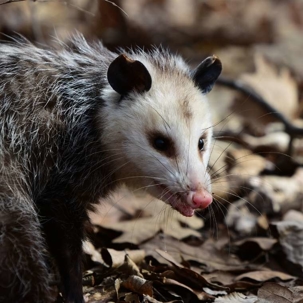Are Opossums Dangerous?
While opossums (also called possums in North America) are generally not aggressive and rarely pose a direct threat to humans or pets, there are several ways they can still be considered potentially dangerous or problematic, particularly when living close to homes or businesses. Below is a detailed breakdown of the main health, safety, and property risks associated with opossums:
Disease Transmission
Opossums can carry and spread various pathogens, parasites, and zoonotic diseases, even if they appear healthy. While they are less likely than raccoons or skunks to transmit rabies (due to their lower body temperature), they are still capable of spreading other harmful agents:
Leptospirosis: Bacteria shed in urine that can contaminate soil, water, or food sources and infect humans or pets.
Tularemia: A bacterial infection transmissible through contact with contaminated carcasses or excrement.
Salmonella: Often spread through contaminated feces, posing a risk in gardens, compost, or around pet feeding areas.
Tuberculosis and coccidiosis: Occasionally associated with opossums in unsanitary conditions.
They can also harbor fleas, ticks, mites, and lice, which may transmit other diseases to pets or humans, such as Lyme disease, spotted fever, or flea-borne typhus.
Contamination of Food and Water Sources
Opossums frequently scavenge in garbage bins, compost piles, gardens, barns, and pet feeding areas. In doing so, they can:
Contaminate food and water with urine, feces, or saliva, which may carry bacteria such as Salmonella or Leptospira.
Spoil stored animal feed or grain in barns and sheds, creating a health risk for livestock and pets.
Pollute backyard ponds, bird baths, or pet water dishes, especially when these serve as frequent drinking or bathing spots for opossums.
This contamination risk is especially problematic for small children, pets, and livestock, who may come into contact with affected areas without realizing it.
Property and Structural Damage
Opossums are opportunistic scavengers and can cause considerable mess and damage when seeking shelter or food:
Nest in attics, crawl spaces, sheds, or garages, where they tear insulation, chew wiring, and leave droppings and urine that cause foul odors and contamination.
Raid garbage cans, compost bins, and pet food bowls, scattering debris and attracting other pests like rats or flies.
Destroy gardens or crops by feeding on fruits, vegetables, and birdseed.
Electrical and Fire Hazards
Opossums nesting in attics, crawl spaces, or walls often use insulation and wiring materials for bedding. This can lead to:
Chewed electrical wires, increasing the risk of shorts or electrical fires.
Blocked ventilation ducts or insulation displacement, leading to reduced energy efficiency or potential HVAC damage.
Even a single opossum nesting inside a structure can create thousands of dollars in repair costs if left unchecked.
Aggressive or Defensive Behavior
While opossums are usually docile and prefer to “play dead” rather than fight, they can become aggressive if trapped, handled, or threatened. When cornered, they may:
Hiss, growl, or bare their teeth.
Lunge or bite defensively.
Though rare, these encounters can result in bites that may become infected and require medical attention.
Threats to Pets and Livestock
Although not naturally predatory toward larger animals, opossums can:
Fight defensively if cornered by dogs or cats, potentially causing bites or scratches.
Spread parasites to pets, particularly fleas and ticks.
Raid chicken coops and consume eggs or small chicks if given access.
Attracting Secondary Pests and Predators
When opossums frequent a property, they often draw other pests as well. For example:
Their droppings and leftover food scraps can attract rats, flies, cockroaches, and ants.
Their nesting areas can harbor parasites that spread to other wildlife or pets.
In rural or wooded areas, opossums may attract predators such as coyotes, foxes, or large dogs that come to hunt or scavenge around them.
This creates a cascade effect, amplifying pest problems and safety risks.
Sanitation and Odor Problems
Opossum droppings, urine, and nesting materials can create strong, persistent odors and unsanitary conditions. Decomposing carcasses, if an opossum dies in an inaccessible area (like a wall void), can cause severe odor and biohazard issues.
Odor and Biohazard Concerns from Carcasses
If an opossum dies in an attic, wall void, or crawl space, the decomposition odor can become unbearable within days. The resulting contamination may include:
Maggot infestations and secondary insect activity.
Airborne bacteria that can affect indoor air quality.
Costly remediation or structural cleanup to remove the carcass and neutralize odor.
Vehicle and Road Hazards
Opossums are nocturnal and often scavenge along roadsides, leading to a high rate of vehicle collisions. Not only are they at risk themselves, but a sudden swerve to avoid one can create traffic hazards.
Vehicle and Infrastructure Hazards
Beyond road collisions, opossums can create indirect safety risks:
They may climb into car engines or under hoods for warmth, particularly in cooler months, where they can cause wiring damage or be injured when the vehicle starts.
Opossums living near culverts, drainage pipes, or basements can clog water flow with nesting debris, leading to flooding or structural issues.
Psychological and Emotional Stress
For homeowners, especially families with children or pets, discovering an opossum in the attic, crawl space, or garbage area can cause considerable anxiety. The noises they make—scratching, hissing, or thumping—can:
Disturb sleep or peace of mind.
Create fear of disease or bites.
Lead to ongoing stress until professional removal is completed.
Opossums are not inherently aggressive or vicious animals, but they can still pose dangers through disease, property damage, and unsanitary conditions. Their presence in or around homes should be handled carefully—preferably through our professional wildlife control services that can remove them humanely, seal entry points, and sanitize affected areas. The combination of disease risk, property damage, and sanitation problems makes it essential to address any opossum intrusion quickly and professionally.

